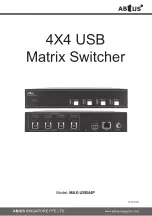
multiSwitch – user manual
© TOPEX 2008 9
In this case, each session packet does not monopolize a circuit. Instead, it is sent only when
the circuit is idle. In this way, multiple sessions can share one channel asynchronously. Thus, the
circuit utilization ratio is considerably increased.
Furthermore, the digital compression technology is adopted in packet transmission. Therefore,
the circuit utilization ratio is many times higher than that of circuit switching. In addition, the charging
mode of packet transmission is irrelevant to the distance. This tremendously reduces the IP costs.
At present, with the application of multiple QoS-ensuring technologies such as the queue,
priority, RSVP, VPN and MPLS, the IP network technology is developing towards a higher rate and
better QoS.
Moreover, with the IP telephone technology, the communication cost can be saved
considerably. This determines its tremendous market potential.
With the driving of the market, more and more research institutes, international
standardization organizations, manufacturers etc. are devoting themselves to the development of IP-
related technologies, thus enabling it to reach the degree of commercialization.
1.4 IP Voice Coding and compression modes
The transmission of real time voices via the IP network is different from that of ordinary data.
In the former case, the relevant application devices must meet the real time of voices. The voice
packet transmission requires the network to provide sufficient bandwidth in time.
Therefore, for most of the current IP networks that do not provide so high rates, the voice
compression technology is the key for implementing IP voice communication. Now, we will present a
brief description of the frequently used voice coding and compression modes at present:
PCM
-
Pulse code modulation
is the earliest digital voice technology, which does not include any
compression algorithm. It transmits voice signals with the 64kbps bandwidth, i.e., taking 8,000
samples per second and acquiring an 8-digit voice signal per sample. PCM is the standard coding
mode adopted in G.711.
CELP
-
Code excited linear prediction
(CELP) is the most advanced voice transmission technology
at present. The CELP algorithm is to compare analogue signal samples with curves in the
predefined code book; send codes in the code book closest to these analogue signal samples to
the receiving end; and regenerate original signals after comparison again with the code book at
the receiving end. The sampling interval of original signals is very short. Therefore, the
regenerated signals are very close to the original signals after being filtered. CELP is the basis of
numerous advanced patented voice compression modes. Voices can be compressed to 5.3 kbps,
8 kbps or 9 kbps.
CS-ACELP
- Conjugate structure algebra code excited linear prediction (CS-ACELP) or G.729 is the 8
kbps voice compression and coding standards of International Telecommunications Union (ITU).
CS-ACELP is a new algorithm, which is able to encode 8kbps voice signal bit streams (while the
rate of ordinary PCM signals is 64 kbps). The bandwidth efficiency is eight times as that of PCM
and four times as that of 32 kbps ADPCM. At present, CS-ACELP is the most welcome voice
encoding/decoding plan.
When actually selecting a voice compression algorithm, it is necessary to take various factors
into consideration. For example: the pursue of higher bit rates guarantees sound voice quality but
requires to occupy more system resources. While lower bit rates will influence voice quality and
increase delay.
Therefore, to keep better voice quality in the precondition of lower bit rates is the principle for
compression algorithm selection.










































